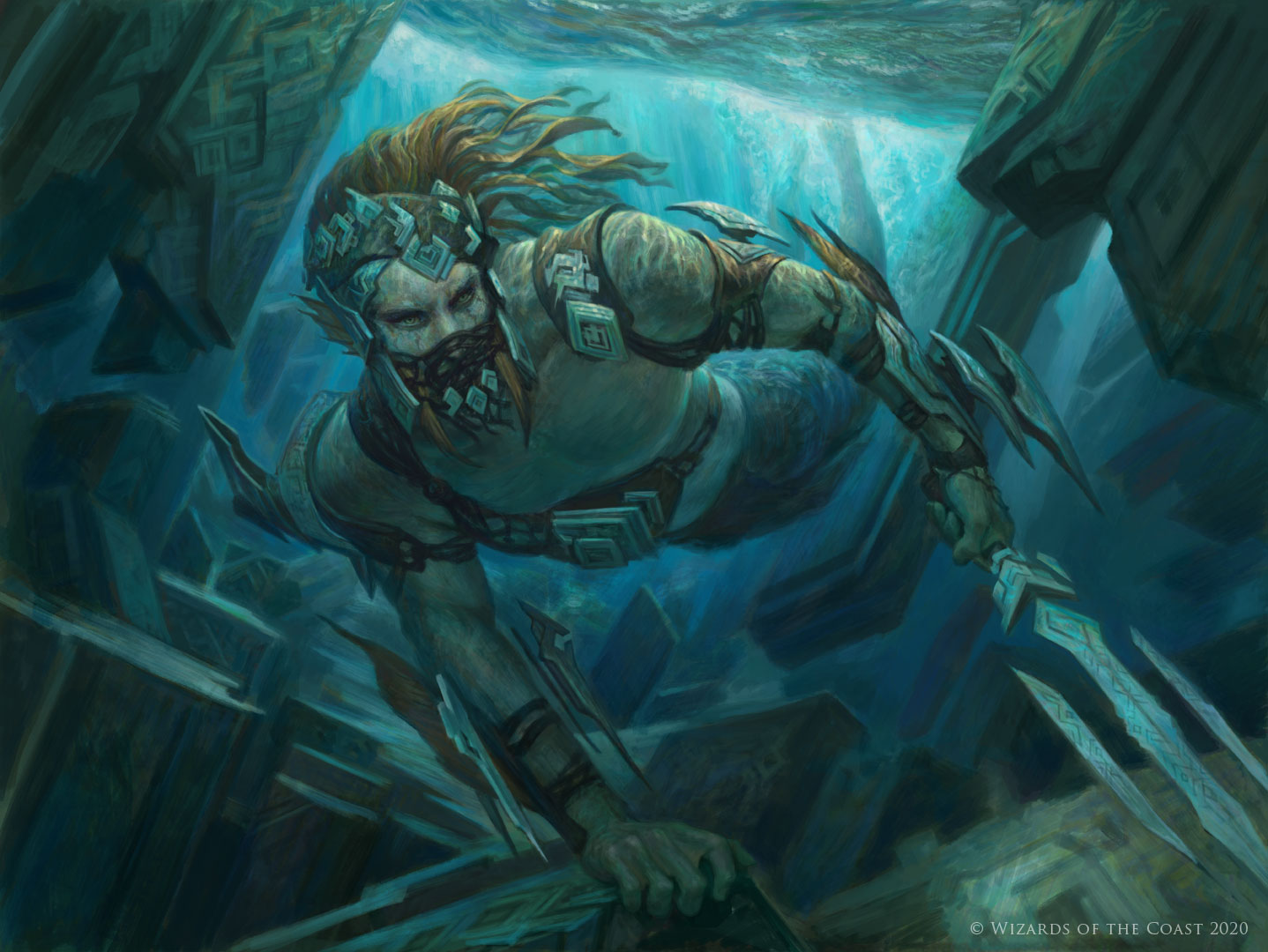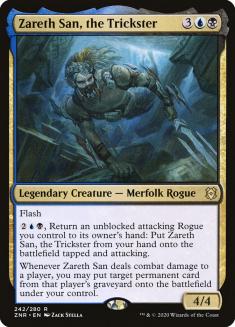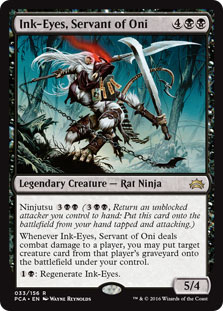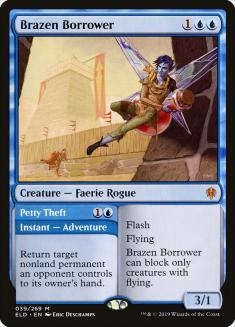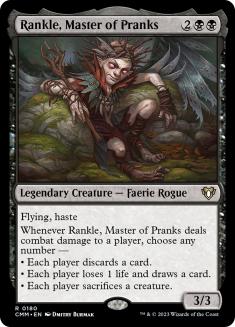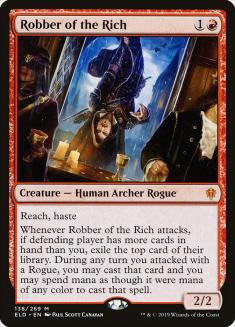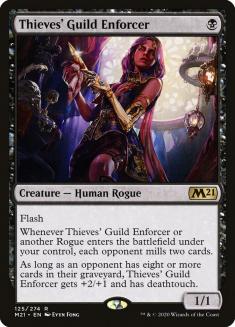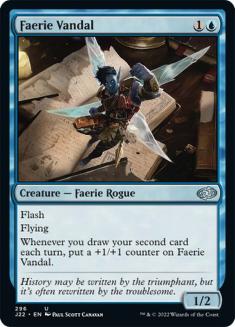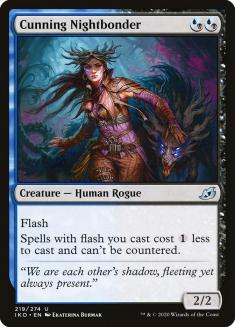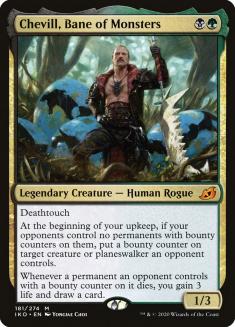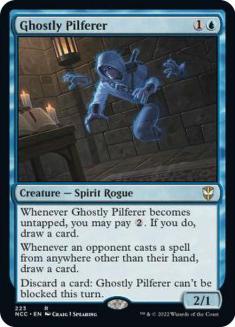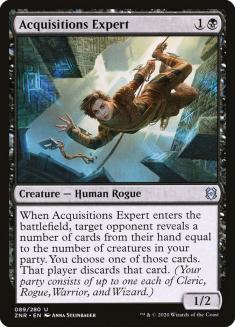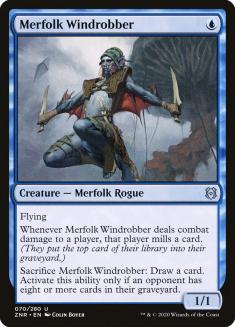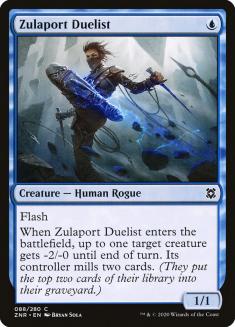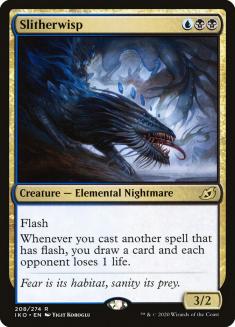As you may or may not know, I’m naturally drawn to Dimir cards, especially the ones with flash. As such, it’s no surprise that Zareth San, the Trickster was the card that most caught my eye from the recent Zendikar Rising previews.
Zareth San is very similar to a card that we’ve already seen, and that I played a lot of back in the day:
Zareth San doesn’t have the keyword ninjutsu, but it’s almost functionally the same — it dodges counterspells and gets to enter the battlefield after blockers have been declared, which means it’s effectively unblockable for that first attack. That said, there are a couple of very important differences between Zareth San and Ink-Eyes:
First, Zareth San can get any permanent, whereas Ink-Eyes can only get creatures. In a planeswalker world, this is huge. Even if you’re not stealing a planeswalker or a good artifact/enchantment, you can at least sometimes grab a land such as a Fabled Passage from an otherwise empty graveyard.
Second, Zareth San is a much better card to cast. At six mana with no enters-the-battlefield effect, Ink-Eyes is quite a poor card when you’re not ninjutsu-ing it. Zareth San costs only five and can be cast at the end of the turn, which is very relevant when it’s a creature that has to connect to do anything. If you cast Ink-Eyes main phase, they just leave back a blocker – with Zareth San they don’t know they’re supposed to do that. As a 4/4 creature, it can also ambush their attackers and behave sort of like a Flametongue Kavu on steroids in some scenarios. It’s also cheaper if you’re cheating it onto the battlefield.
Third, as far as I know, Zareth San works differently in multiplayer. Remember when I said it was “almost” functionally the same as ninjutsu? Here’s the difference (obviously this is irrelevant for a lot of people, but if you do play Commander…): Zareth San can be used to attack a different person than you originally attacked! Ninjutsu has a specific rule that prevents this from happening, but Zareth San doesn’t have a keyword and is not bound by those restrictions. This means you can attack Player A and, once Player A doesn’t block, you can put Zareth San onto the battlefield attacking Player B, and by this point it’s unblockable. Pretty cool.
I am almost positive this is how it currently works, but of course they could just add an exception to it like they did to ninjutsu, so it’s subject to change (also I’m subject to being wrong on this, as it’s not really my area of expertise).
Then, there are the drawbacks. Zareth San doesn’t regenerate, which is obviously worse, and it’s limited to Rogues only. This means you can’t just throw Zareth San into a creature deck like you could with Ink-Eyes — you have to build around it. Luckily, there are plenty of Rogues that work with it currently in Standard, and we know there will be more in Zendikar Rising, as Rogues are a key creature type for the party mechanic. Even now we already have a couple of Rogues previewed that work quite well with it. Let’s analyse what we’re currently working with:
The Good Rogues
These three have seen a lot of Standard play regardless of the fact that they’re Rogues. Of the three, Brazen Borrower is by far the most exciting, because it’s the one that’s most likely to connect (given that it’s cheap and it flies) and because returning it to your hand actually lets you cast Petty Theft again, giving you some value. If you’ve managed to clear the battlefield, returning Brazen Borrower to your hand ensures that Zareth San will connect again the following turn. I’d be surprised if every Zareth San deck didn’t have four Brazen Borrower as a starting point.
Rankle, Master of Pranks is also a very strong card, but sort of runs into the issue of being too strong — I just don’t want to give up a Rankle attack. Of course, a lot of the time reanimating a permanent from their graveyard is going to be worth more than any number of Rankle effects, but I’m hoping we can do better than returning a four-drop with a strong connecting ability.
Robber of the Rich is very interesting because, even though we rarely use it this way, it’s actually a tribal Rogue card — its ability works with all Rogues. It’s also a strong Rogue itself, especially in a deck that’s likely playing cheap cards. However, it’s red, and our flagship card is Dimir, so it’s going to be a tough sell. Unless we get a Grixis Triome (which doesn’t look like we’re getting this set), I’m skeptical an aggressively slanted deck can be Grixis colors (even a Triome might not be enough).
The Situational Rogues
I’ve tried playing most of these cards before, but I’ve never had much success. Of the four, Chevill, Bane of Monsters is probably the most powerful, but it runs into the same issues as Robber of the Rich in that it’s a card of a third color. However, Sultai does have a Triome and green is better at fixing and playing more lands, so I could see playing a Golgari-based deck that only splashes for Zareth San.
Thieves’ Guild Enforcer is an interesting card because it’s another Rogues payoff. The main issue with the card is that, in this environment, milling them for two cards might not be much of a payoff and more of a detriment, specifically because of Uro, Titan of Nature’s Wrath. Against an Uro deck, playing Thieves’ Guild Enforcer is a surefire way of guaranteeing they will have an Uro on the battlefield very early, and by having access to that card they will also be able to turn off the Thieves’ Guild Enforcer “reverse threshold” ability.
That said, Thieves’ Guild Enforcer works very well with Zareth San on multiple levels. First, it mills them, which means Zareth San is much more likely to hit a strong card. You’re usually limited by whatever your opponent has put in the graveyard, which is likely not going to be much by Turn 4, but with Thieves’ Guild Enforcer you could actually mill a six- or seven-mana card and then reanimate that way ahead of schedule. You could even get an Ugin, the Spirit Dragon on the battlefield as early as Turn 4! In this regard, discard spells work the same way and will probably be valued by all Zareth San decks.
Second, it’s a cheap Rogue to return, and Zareth San is itself a Rogue, so that ensures a lot of triggers — at least one from Zareth San and one from whatever Zareth San bounced that’s going to be recast. This will make it very easy to turn on the passive on Thieves’ Guild Enforcer. Imagine, for example, the following sequence:
- Turn 1: Thieves’ Guild Enforcer, mill two.
- Turn 2: Petty Theft,
- Turn 3: Cast Brazen Borrower, mill two.
- Turn 4: Attack with Brazen Borrower, use the ability on Zareth San. Mill another two cards and now you’ve already almost turned on Thieves’ Guild Enforcer and you have six mills to pick a powerful permanent with Zareth San. Plus, you get your Brazen Borrower back in your hand!
I don’t believe all Zareth San decks will be dedicated Rogue decks, but the ones that are will probably want to play Thieves’ Guild Enforcer, and will then have to find a way to deal with opposing Uros.
Faerie Vandal and Cunning Nightbonder are cards that you can sometimes find in the “flash” archetypes, which has a lot of overlap with Zareth San as a lot of the good Rogues have flash. They both work relatively well with Zareth San; Faerie Vandal is a flyer, which makes connecting easier, and Cunning Nightbonder will lower the cost of Zareth San if you want to hardcast it (though it will regrettably not lower the “ninjutsu” cost). There is a bit of anti-synergy with Faerie Vandal and Zareth San, though, as it will reset all the counters.
Ghostly Pilferer is somewhat of an exception in that I actually haven’t even tried to play it yet. Clearly on power level alone it falls a bit short, but I don’t think it falls too short, especially if there are more Rogue synergies coming. Having an unblockable Rogue is huge for Zareth San so I could see a world in which this sees play.
The New Rogues
We don’t know every new Rogue yet, and there are bound to be many, but we already know several and all of them work quite well with Zareth San.
Acquisitions Expert is a great pairing with Zareth San. Assuming you only have Rogue as a party type (though it wouldn’t be far-fetched to find Wizard in a deck like this as well), it’s a slightly bigger Burglar Rat. Burglar Rat isn’t the most exciting Standard playable (though people *cough* Ben Stark *cough* have Top 8’ed high level events with it before). And it’s true that it’s not a strict upgrade to Burglar Rat, as they can kill it in response, but in a Rogue deck you’ll probably have some other Rogues lying around, and if you don’t, you still one-for-one their removal spell.
When you put Acquisitions Expert alongside Zareth San, however, it becomes much better. First, it’s a cheap Rogue to return that actually has an enters-the-battlefield ability, so rebuying it can be very relevant. Second, because its discard ability will fuel Zareth San.
When we’re hit by something like a Burglar Rat, our first instinct might be to discard our most expensive card, especially if we’re playing versus more discard spells (after all, these are the cards we have for the late-game, and not for Turn 2). Zareth San turns this philosophy onto its head, however, as suddenly discarding your most expensive card can be devastating as Zareth San gets to reanimate it and turn it against you. All of a sudden, you might be forced to discard the two- or three-drop that you were planning on casting, rather than the six- or seven-drop that’s not going to do anything for many turns.
Merfolk Windrobber is an interesting card to pair with Zareth San, as, much like Thieves’ Guild Enforcer, it’s good at enabling powerful steals early on. Unlike Thieves’ Guild Enforcer, though, it actually has evasion, which makes it a prime helper for Zareth San. Past that, it also helps turning on Drown in the Loch and the new counterspell, Anticognition. The downside is the same; in a world of Uro, milling them can actually be a liability. I do believe there’s a nonzero chance Uro is banned in Standard at some point, however, and if that happens then these cards become a lot better.
Nighthawk Scavenger is another Rogue that’s entirely playable on its own — no synergies needed, though it does benefit from them. Vampire Nighthawk was a real card in Standard and this is significantly better; it doesn’t take much for it to be a 3/3 or 4/3 flyer lifelinker for three mana, and as a flyer with deathtouch it’s hard to block, meaning it curves well into Zareth San. If you paid it with Thieves’ Guild Enforcer or Merfolk Windrobber, then it can reasonably attack for four or five power in the air the turn after you cast it.
Zulaport Duelist is the new Rogue with the smallest potential (it strikes me as mostly a Limited card), but even that can be good enough given the right synergies; it is after all a cheap Rogue that mills them and has an ability worth rebuying, but I think you need a little more to make it good and wouldn’t play it without another synergy. I do think there’s a chance Slitherwisp is where you wanna be anyway, and that’s a pretty good synergy, but even then it doesn’t strike me as good enough. I’d sit it aside for now and then revisit it if the format turns out to be very aggressive.
So, what does a Zareth San deck look like? I think there are two potential choices, one focusing on flash cards with Slitherwisp and one without. Here’s how I would approach them:
Creatures (24)
- 4 Brazen Borrower
- 4 Thieves' Guild Enforcer
- 4 Acquisitions Expert
- 4 Merfolk Windrobber
- 4 Zareth San, the Trickster
- 4 Nighthawk Scavenger
Lands (24)
Spells (12)
Sideboard

Creatures (27)
- 1 Faerie Vandal
- 4 Brazen Borrower
- 4 Slitherwisp
- 4 Thieves' Guild Enforcer
- 4 Acquisitions Expert
- 4 Merfolk Windrobber
- 4 Zareth San, the Trickster
- 2 Nighthawk Scavenger
Lands (24)
Spells (9)
Sideboard

This is a little light on flash cards for Slitherwisp; there are seventeen total, which is normally plenty, but you’re not trying to cast Zareth San that often, so it’s effectively less than that. I think the card is still worth trying, though, since it fuels itself and works if you re-buy a Rogue with flash with Zareth San. Depending on whether the next good Rogues to be previewed have flash or not, we can then lean more on Slitherwisp or remove it altogether, but either way I’ll be looking at the previews with high expectations.

